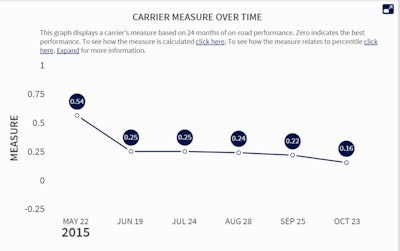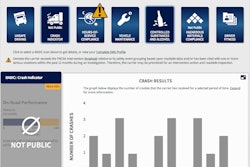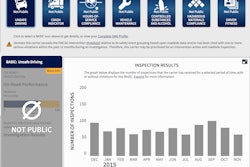Contrary to reporting last month that the Federal Motor Carrier Safety Administration’s public unveiling of a modified CSA Safety Measurement System represented the end of substantive updates to the public display, carriers’ so-called “absolute measures” in individual BASIC categories will be returned to the SMS’ public view with the February update, says agency spokesman Duane DeBruyne.
 One carrier’s “absolute measure” in the Vehicle Maintenance BASIC shown changing over time in the CSA SMS, before it was pulled from view by Congressional directive in December.
One carrier’s “absolute measure” in the Vehicle Maintenance BASIC shown changing over time in the CSA SMS, before it was pulled from view by Congressional directive in December.“The Agency anticipates that in March, with the February snapshot, carriers’ absolute measures will be returned to the website,” DeBruyne said after being queried about rumors circulating around the absolute measures. The update is expected to come during the first full week of next month.
The absolute measure, illustrated above for one carrier in the Vehicle Maintenance BASIC, represents a time- and severity-weighted calculation of a carrier’s violation performance in each BASIC. The higher the number, per the CSA SMS’ methodology, the worse the performance. CSA scores, or the percentile ranking carriers receive in each BASIC, are directly based on comparing the absolute measures among groups of carriers. You might think of the absolute measure as the violation-performance grade before the curve is applied (though the measure is not that simple).

Though the FAST Act highway bill required the percentiles and evaluative BASIC alerts to be removed from public view, DeBruyne noted that, as has been reported in Overdrive, the bill specifically allowed for the retention of the absolute measures in the SMS public display.
While such measures may ultimately be less problematic for carriers than the comparative percentile rankings, the jury’s out on whether those numbers may ultimately become safety evaluation standards in and of themselves. The recent release of the Safety Fitness Determination notice of proposed rulemaking to tie safety rating in part to SMS data complicates matters.
Avery Vise, president of the TransComply company, sees the move as a step toward enacting the January-issued Safety Fitness Determination proposal. “I think [FMCSA ] may go ahead and do on the SMS website more or less what they’re proposing to do” in the proposed SFD rule, he says. That rule, if made final, would utilize those absolute BASIC measures against fixed percentile thresholds in part to determine carriers’ fitness for duty.
Publication of fixed thresholds for those measures in each BASIC, giving viewers points on the continuum of measures against which to evaluate a carrier, might be the next step for the agency, by such logic. The Safety Measurement System itself is, after all, a malleable creation that FMCSA has modified in a variety of ways over time.
However, there is no indication as yet the agency will in fact go that route prior to the Safety Fitness Determination proposed rulemaking making its way through all appropriate notice, comment and evaluation periods required of significant regulations. You can evaluate the SFD on its merits via our prior coverage, and the proposed rulemaking remains under an initial 60-day public comment period. Those wishing to comment can do so via this link to Regulations.gov.
The more definite wild card in the return of absolute measures resides in the question of just how third parties will treat them.
Inclusion of the absolute measures makes plain something of a fundamental point about the SMS. “Some will still try to use the SMS to argue that someone is less safe than someone else,” says Vise. That in spite of many in Congress and those throughout the industry who believe that the SMS’ underlying data and methodology, which has not changed as yet, is simply not legitimate, whether time- and severity-weighted violation performance in each category is illustrated by a percentile or by an “absolute measure.”
The FAST Act did more than just require the removal of public percentiles in each BASIC — it directed the agency to work with the National Academies to review and potentially revamp the program before returning to business as usual.
At the least, including the absolute measures in the public display gives private developers all they may need to make the CSA SMS’ percentile calculations on their own, whether the agency takes the SMS website in new directions or not — and whether the availability of inspection/violation information wasn’t already sufficient for such developers, as has been suggested by many watchers.
Congressional oversight, represented by the public-view-related and review-and-revamp requirements in the FAST Act, may have put a dent in the SMS, in other words, but it didn’t knock it down entirely.
UPDATE 1:35 p.m.:
The Transportation Intermediaries Association, in a brief provided to TIA members on the subject, called the FMCSA’s move to return the absolute measures to public view one that will “only further generate confusion in the marketplace when hiring a motor carrier and will give the trial bar another arrow in its quiver to seek judgment” against third parties for negligent selection.
The TIA went to note that it viewed use of SMS data as problematic, to say the least: “It has been and will remain TIA’s position that the safety rating is the sole determination of whether or not a carrier is safe to operate or not and that all CSA data and scores should be removed from public view in their entirety.”










